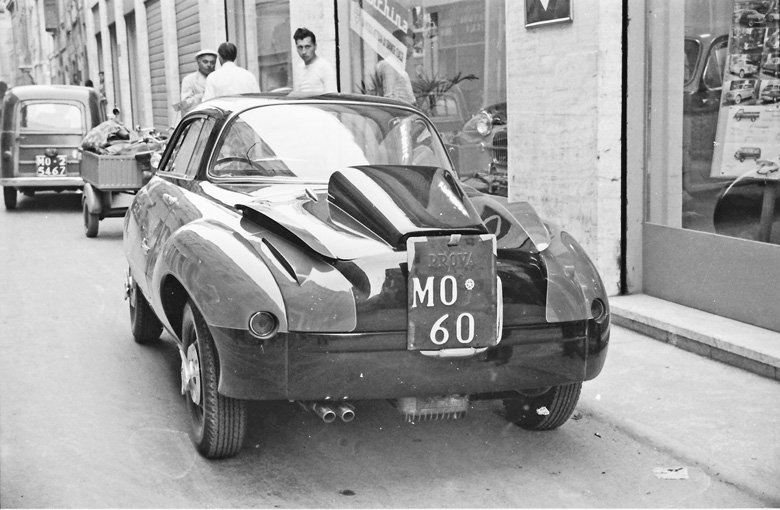
The Vignale “Goccia”. Gauld took this photo in 1957, only to find the same car at a motor show in 1999, plus the Fish and the Pinin. Read on!
Story and photos by Graham Gauld
As most of you probably know there was a motor show in Geneva last week, where all the attention appeared to be on supercars with weird and wonderful aerodynamics; it all looked terribly serious. Editor Pete asked me if I was going to attend the show, but had to admit that it has been about twenty years since I attended the big salons of Geneva and Paris..
I knew that Pete will have plenty of photos of the Geneva event from other correspondents so wasn’t too worried. However, Pete’s comments reminded me of an interesting show I attended in 1999. It was organized by the well-known Italian collector Franco Lombardi in his home town of Genoa and I knew I had to be there. I was not disappointed! So to get you into the Motor Show mood let me tell you about three of the cars there.
The Fish
The first one was completely new to me but interesting. It was a Fiat 509 built between 1925 and 1929. It was an important car for Fiat as it was the first truly mass produced car in their line with a 990cc four cylinder engine that produced a modest 22 bhp. It was clearly a car for the middle class and Fiat sold around 90,000 of them including truck and taxi versions. The car on show, however, was completely different as it was built as a sports car. At the time you could buy a complete chassis/engine unit and take it to a coachbuilder and have it built to your own style.
Such was the case with this 509A model which was called the “Delfino” or Dolphin. You just need to look at the photo to see the reason that was its name as it was designed to look like a fish complete with tail fin.
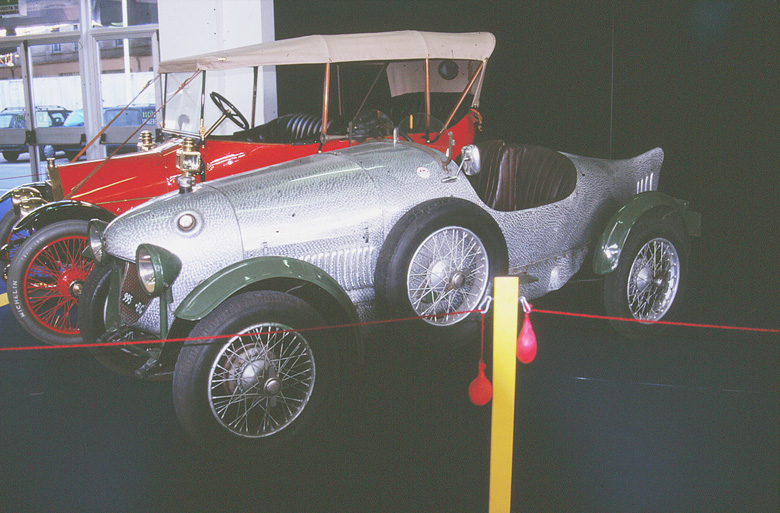
The Fiat Dolfino. Notice the shape of the nose to look like the mouth of a fish, they eye on the hood and the fish tail.
The original owner was the Mayor of Bergamo in Northern Italy, Giuseppe Bonaldi. He sent the chassis to the Milanese coachbuilders Martelleria Italiana Panzeri, Riva & Lavari who designed this fish-shaped body. Bonaldi obviously enjoyed having the car. But when Benito Mussolini called upon all Italians to donate their cars to the government so that they could be melted down and made into the production of guns, Giuseppe, true to the cause, offered his Delfino and promptly had it returned minus engine and transmission because the bodywork was in aluminum and no use for making guns.
The bodywork was actually designed a built in two half-shells welded and jointed and was complete with a nose shaped like the mouth of a fish, two eyes and the aluminum body hammered to look like the scales of a fish. To make it even more realistic it was finished in a transparent coating with gave the shiny effect of fish scales.
The Bonaldi coachwork eventually disappeared and finally surfaced in the 1970s. Fortunately someone recognized it and restoration commenced. An original 509 Fiat chassis and engine was found and the Fish swam again.
Today it is still a runner and appears from time to time in various shows, and it still carries its original Italian registration number.
The Teardrop
I will try not to bore you too much. Bear with me. When I walked into that Genoa Show and saw this Fiat 750 Abarth Vignale I was rooted to the spot.
Forty two years earlier, I had not only seen the car outside the tiny Vignale showroom in Modena, but had sat in it and later followed it to Modena Autodromo. For the life of me I cannot remember the name of the street but there was this stunning red and black coupe parked in front of the showroom with the manager and a salesman clearly with the impression that I might want to buy it. It was a little gem of a car.
It was one of three Vignale coupes called the “Goccia” (Teardrop) built in 1957, two on 600/750cc chassis, and a smaller version based on a Fiat Abarth 500 chassis. The first 750 was shown at the Geneva Motor Show and had gull-wing doors. But this was the second version and had normal doors. What made them special was the needle nose and front end streamlining – which is more than can be said for the rear. As can be seen in the close up from the back it had various scalloped air vents to cool the engine and the general shape of a brick!
The whole design was by Giovanni Michelotti for Vignale and it was timed at 150 kph (93 mph) which was sensational for a 750cc road car in period.
The car I saw at the Vignale showroom in Modena was brand new and I have a picture I took inside the car where the dealership had put down sheets of paper to cover the pristine floor mats.
And the Pinin Maserati
As I mentioned earlier, Franco Lombardi was organizer of the show at Genoa, also called “Autostory”. Franco had just taken delivery of a spectacular restoration project he had been sitting and pondering about for years, his Maserati A6GCS Pinin Farina Coupe, and perhaps wanted to use the Genoa show to display his latest project.
The story behind this car is slightly complicated so let me cut to the chase.
In 1954 Guglielmo “Mimo” Dei, best known as owner of Scuderia Centro Sud racing team, took delivery of four Maserati A6GCS chassis and engines as he had an idea to produce four rather special cars. As he was the Maserati dealer for Rome he had the ear of Maserati and so that was no problem. He asked Pinin Farina to design berlinetta bodies for all four cars but two of them, chassis 2057 and 2060 were later rebodied as barchettas.
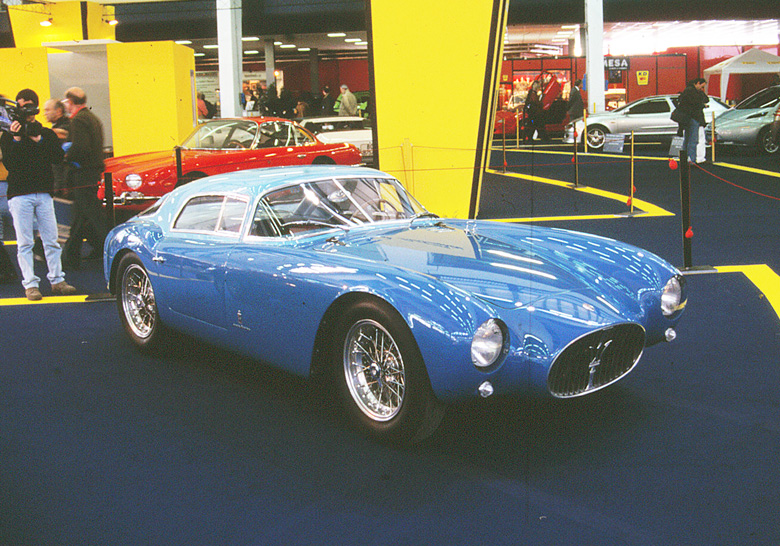
Franco Lombardi’s Maserati A6GCS Pinin Farina Coupe being shown for the first time after its restoration in 1999 at the Genoa show.
The first chassis, 2057, was finished in time for the April 1954 Turin Motor Show where it was shown resplendent in its two-tone blue bodywork and got a lot of attention and was sold to Piero Palmieri. It was later converted to a Fantuzzi barchetta. However when it was converted Mimo Dei kept the Pinin Farina berlinetta bodywork in the back of the shop. In the 1970s when Centro Sud filed for bankruptcy the bodywork passed on to a collector and ended up with the legendary Corrado Cupellini.
In December 1977 Franco Lombardi bought the bodywork along with an original A6GCS chassis and engine (No. 2070). Franco, never one to rush at things, kept the Pinin Farina bodywork along with his chassis and engine in the garage until finally deciding to send everything to Giovanni Giordanengo the coachbuilder from Boves near Cuneo in 1995. It was a difficult job and one of the difficult problems was re-creating the split windscreen – the only Pinin Farina Berlinetta made with a split screen.
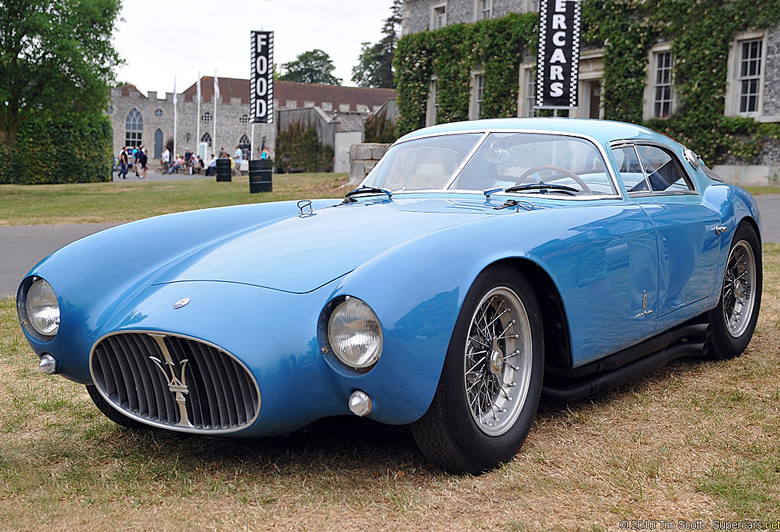
The Maserati as it looks today, still owned by Franco Lombardi but now single color blue. Note the split windscreen and its lowered body compared to the other Pinin Farina Berlinettas.
Four years later, Franco presented his rebuilt Pinin Farina Berlinetta 2070/2057 at his own Autostory motor show. At Bagatelle in Paris later that year it won the Prix du Trionon and today the car is still in his collection. He took it to Goodwood for the Revival meeting a few years ago where it created a bit of a sensation and remains one of his favorite cars. I am indebted to Franco and to David Walmsley for some of the background information.
After looking at the photographs of the 2017 Geneva Motor Show I wonder how many of the cars will have similar stories to tell sixty years from now?
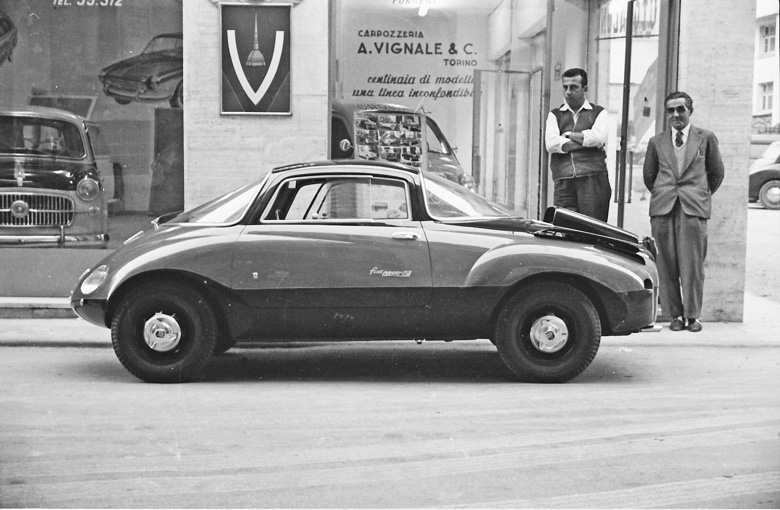
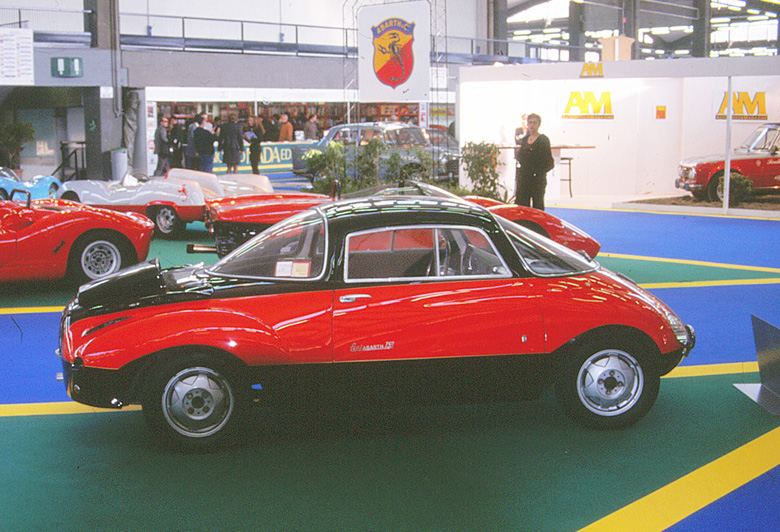
Sorry to be pedantic, but Franco Lombardi’s lovely A6GCS is not a single colour blue, but still very much two-tone. Further, he brought it to the Festival of Speed (in 2010), not the Goodwood Revival.
Another great piece by GG. These are truly AMAZING machines. Thanks Graham for telling us about them. You certainly have a knack of finding something ‘different’ to tell us about.
Graham,
I asked Gauld about this… “Reference the comment. I am very much aware that when I took the shot in 1999 in Genoa, the Maserati was two tone blue but as Franco Lombardi specifically sent me the Goodwood photograph for the article I assume that it was blue.”
Pete